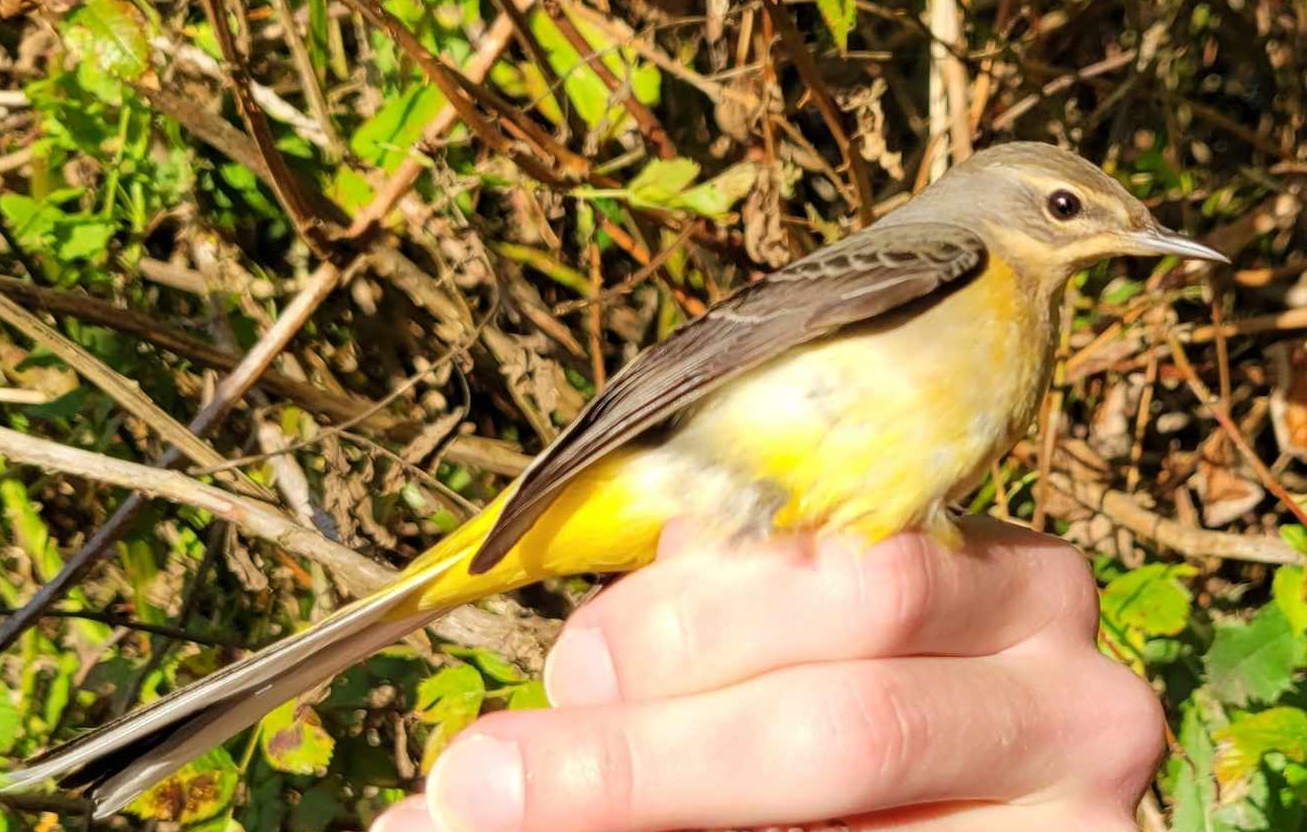Gedser Fuglestation Blog
Her på Gedser Fuglestations blog bringes korte nyheder i dagbogsformat om hændelser på fuglestationen.
Simple bird love
Ringmærkningen:
Dagens bedste: Bjergvipstjert
Igen en travl dag med 9 forventningsfulde kursister og 4 instruktører, samt besøg af af Jesper Johannes fra Museet.
Vi håbede på at få en god portion fugle oven på de 2 sidste dages dårligt fangstvejr og det lykkedes heldigvis.
En lang og dog hyggelig dag, hvor vi holdt nettene åbne helt til kl. 16. Men så var det også ved at være udsolgt på alle hylder og bloggen her blev lavet i al hast efter alle andre var gået i seng.
Og det vil jeg så også nu .
Fangster:
Migration count at Gedser Odde
by Lara W
Dawn came with exquisite colours and cloud formations, looking rather like a cityscape skyline along the horizon. A westerly wind brought 45 species across the point, totalling 1,792 individual birds, including quite a variety of passerines and raptors. Several gull species are now migrating in greater numbers too, although fewer and smaller flocks of duck were spotted in comparison to the previous week.

Photo credit: LAH
Of the passerines, in some cases, quite a number were counted going north as well as flying south. For instance, 15 Meadow pipit/Engpiber (Anthus pratensis) flew south in comparison to 85 north, 90 Chaffinch/Bogfinke (Fringilla coelebs) flew south and 65 north, and 26 Reed bunting/Rørspurv (Emberiza schoeniclus) flew south to 42 north. As mentioned in a previous blog post (“Day of the Scoter” from 15.09.2024), this could be due to the insistent need within the avian brain at this time of year to migrate, despite the wind direction forcing birds to fly off course. Other passerines counted today which were of note were 8 Song thrush/Sangdrossel (Turdus philomelos), 17 Starling/Stær (Sturnus vulgaris), 49 Siskin/Grønsisken (Spinus spinus), and a single Redwing/Vindrossel (Turdus iliacus). Redwings are truly quite beautiful birds, sporting a lighter build than many others within the thrush family, with a strong pale supercilium (eyebrow marking), and soft rufous colouring underneath the wing across the armpit region. Any ringing readers will also appreciate this bird for being rather quieter in the hand than their much louder cousins (looking at you Song thrush)!
10 species of raptor were spotted today, including 6 Marsh Harrier/Rørhøg (Circus aeruginosus), 3 Hen Harrier/Blå Kærhøg (Circus cyaneus), 3 Osprey/Fiskeørn (Pandion haliaetus), and 16 Honey Buzzard/Hvepsevåge (Pernis apivorus). Around midmorning, a striking Black Kite/Sort Glente (Milvus migrans) was seen circling above the field in company with 3 Red Kite/Rød Glente (Milvus milvus), ensuring the drastic differences in plumage were clearly contrasted. Three White-tailed eagle/Havørn (Haliaeetus albicilla) were also spotted, 2 of these soaring high up in the clouds above the sea later in the afternoon. The first, a juvenile judging from the lack of white on the tail feathers, flapped patiently around the field behind the point in a rather dignified manner, pointedly ignoring the flock of stressed Hooded Crow/Gråkrage (Corvus cornix) that attempted to drive the much larger bird off. A rather entertaining view of interspecific behaviour.
Of the smaller raptors, 14 Kestrel/Tårnfalk (Falco tinnunculus), 3 Merlin/Dværgfalk (Falco columbarius), 47 Sparrowhawk/Spurvehøg (Accipiter nisus), and 2 Hobby/Lærkefalk (Falco subbuteo) were seen migrating. We were treated to a couple of occasions watching Merlin hunt passerines just off the coast, perhaps catching a few meals before attempting the crossing later in week. The speed and agility of these birds is wonderful to behold. Evolution is a continual process, and the infinitesimal mutations between generations making both the hunter and the hunted swifter, more dexterous, more sensorily advanced, is an exquisite battle of nature evident in any such observation. Having said this, later on in the afternoon, I found myself within two feet of a sparrowhawk who had jinxed around the corner and attempted to perch on the metal railing behind me. I was as surprised as he was…perhaps further sensory evolution is required!
Further out on the sea, we had the usual suspects, although in lower numbers than earlier in the week – 411 Common Eider/Ederfugl (Somateria mollissima), 325 Wigeon/Pibeand (Anas Penelope), 31 Pintail/Spidsand (Anas acuta), 49 Teal/Krikand (Anas crecca), and 41 Common scoter/Sortand (Melanitta nigra). Skimming above the waves, we were treated to 3 Arctic skua/Almindelig Kjove (Stercorarius parasiticus), one of which I managed to watch for quite some time as it approached the shore, eventually bullying a gull into dropping a fish in typical kleptoparasitic behaviour. A steady flow of Sandwich tern/Splitterne (Thalasseus sandvicensis) passed both south (80) and north (48), along with 43 Common gull/Stormmåge (Larus canus), 16 Herring gull/Sølvmåge (Larus argenteus), and 3 Little gull/Dværgmåge (Hydrocoloeus minutus). 2 Red-throated Diver/Rødstrubet Lom (Gavia stellata), 1 Red-necked Grebe/Gråstrubet Lappedykker (Podiceps grisegena), and 69 Cormorant/Skarv (Phalacrocorax carbo) were also counted. Although only 16 Dark-bellied Brent goose/ Knortegås (Branta bernicla) were spotted during the standard morning count period, several larger flocks were seen migrating later on in the afternoon.
All in all, a rather eventful day out on migration. Thank you to my good friends Larissa Britton, Mads Elley, LAH, and Gert for their companionship and expert birding skills, whilst simply appreciating these wonderful birds together.
At the station: Lara Winsloe, Larissa Britton, Vagn Lind og mange kursister og instruktører



